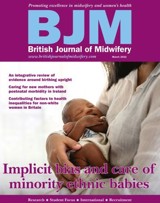References
Offering vaginal examinations

Abstract
Sophie Franks reflects on her experiences on a labour ward and women's right not to consent to a vaginal examination
Recently, on a busy, understaffed NHS labour ward, I experienced significant pressure from a senior colleague to conduct a vaginal examination on a woman who had declined one after a balanced discussion and for whom it was not clinically indicated. For approximately 2 hours until the shift ended, I faced repeated requests to do the vaginal examination and exasperated looks when I reiterated the woman's wishes and lack of clinical indication for an examination.
I ended that shift feeling proud to have been a true advocate for that woman, but paradoxically demoralised at what I feel to be the state of midwifery in the NHS now. When did ‘offering’ (National Institute for Health and Care Excellence, 2017) a vaginal examination come to mean ‘coercing’? Or is it that women are not truly being offered vaginal examinations in labour and given the opportunity to accept or decline, but instead are being coerced or guided into having them to meet the needs of institutions and clinicians? The cynic in me, after 8 years in clinical practice, suspects it is the latter.
Register now to continue reading
Thank you for visiting British Journal of Midwifery and reading some of our peer-reviewed resources for midwives. To read more, please register today. You’ll enjoy the following great benefits:
What's included
-
Limited access to our clinical or professional articles
-
New content and clinical newsletter updates each month

